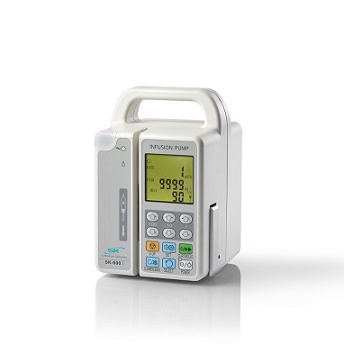A Baxter InternationalColleague CX infusion pump
There are two basic classes of pumps. Large volume pumps can pump nutrient solutions large enough to feed a patient. Small-volume pumps infuse hormones, such as insulin, or other medicines, such as opiates.
Within these classes, some pumps are designed to be portable, others are designed to be used in a hospital, and there are special systems for charity and battlefield use.
Large-volume pumps usually use some form of peristaltic pump. Classically, they use computer-controlled rollers compressing a silicone-rubber tube through which the medicine flows. Another common form is a set of fingers that press on the tube in sequence.
Small-volume pumps usually use a computer-controlled motor turning a screw that pushes the plunger on a syringe.
The classic medical improvisation for an infusion pump is to place a blood pressure cuff around a bag of fluid. The battlefield equivalent is to place the bag under the patient. The pressure on the bag sets the infusion pressure. The pressure can actually be read-out at the cuff’s indicator. The problem is that the flow varies dramatically with the cuff’s pressure(or patient’s weight), and the needed pressure varies with the administration route, potentially causing risk when attempted by an individual not trained in this method.
Places that must provide the least-expensive care often use pressurized infusion systems. One common system has a purpose-designed plastic “pressure bottle” pressurized with a large disposable plastic syringe. A combined flow restrictor, air filter and drip chamber helps a nurse set the flow. The parts are reusable, mass-produced sterile plastic, and can be produced by the same machines that make plastic soft-drink bottles and caps. A pressure bottle, restrictor and chamber requires more nursing attention than electronically controlled pumps. In the areas where these are used, nurses are often volunteers, or very inexpensive.







Reviews
There are no reviews yet.